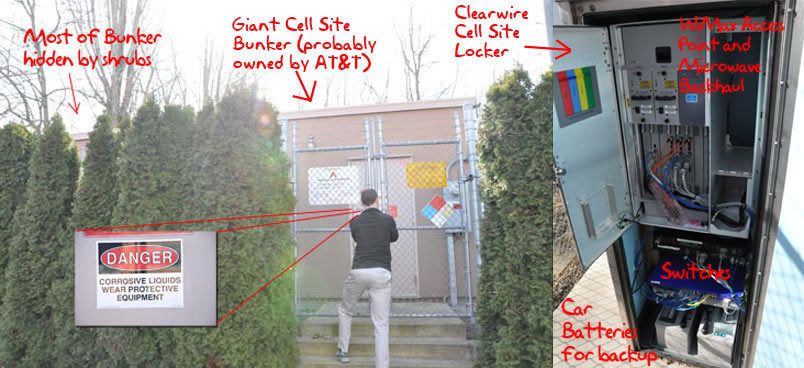I recently visited a cell site shared by Clearwire and two other unnamed carriers—without frying my nuts. We've all driven past them so many times, but have you ever actually wondered how they work?

How They Work
Whether it's handling simple phone calls or 12Mbps WiMax data, cell sites are organized with more or less the same flow:
• A cellphone or modem radios the nearest towers, saying, basically, "I'm here!" When you make a call or logon, your phone then sends a message via radio that's picked up by the antenna array.
• A wire or fiberoptic line carries the call down to the wireless access point, connected to a multi-port switch.
• The call, along with many others, gets routed to a backhaul, usually down to an underground wired T1 or T3 line, but sometimes back up the mast to a powerful line-of-sight wireless microwave antenna. They resort to wireless either when they don't have a ground connection, or when the ground connection sucks.
• The incoming call or data comes back from the backhaul and up through the switch to the antenna, where it then hits your phone wirelessly, presuming your phone is still communicating with the same site. If you are moving, then there's a handoff—a new but more or less identical cell site transmits the data to your phone, once your phone checks in and says "I'm here."
All of this happens in the blink of an eye.
The Gear
Clearwire, who gave me the tour of the cell site during my WiMax test run, is a new company, only just now deploying their network, one that is only focused on data, and not on voice calls. This means they don't have a bunch of sites already established like other carriers (though their recent acquisition by Sprint may change this). But it also means their cellular gear is modern and compact compared to the others.
For instance, the carrier whose name probably starts with A keeps its gear in a bunker like the Endor moon one that Han Solo & Co. were trying to bust into in Jedi. The backup batteries must be enormous, because there's a sign on the door that says, "Danger - Corrosive Liquids - Wear Protective Equipment."
Clearwire, by comparison, has a high-school locker for its gear—one that is built somewhere else and just trucked to the location. You attach it to the on-site power, run lines and antennas up the mast, and either bolt the sucker to a cement foundation or to the side of a steel post, and voila, you are done. It uses two car batteries for its backup power—enough juice to last six hours and they don't have to wear a hazmat suit to service it. (It can also run off of a portable generator.)
In this particular site, the carrier whose name may start with a V had a set of three larger lockers, not the huge bunker that its competitor had, but a serious array nonetheless. As you probably guessed, each carrier locks up its own facility, so I wasn't at liberty to fully inspect the other guys' gear—or even confirm their identities.
Clearwire also runs skinny fiberoptics up to the top of the tower, instead of the thick insulated copper cables that the old boys' networks run. Again, this has more to do with newness than simple common sense, but it may mean cell towers could be a little slimmer in the future.
So what happens up top?
The real demystification was the antenna array itself. I for one did not know a lot about how things were set up, and now I know a tiny bit more, which I will share:
• The huge antenna masts can have multiple carriers, each with its own triangular platform and antenna array.
• The reason the platforms are triangular is so the 360-degree coverage can be split into 120-degree pie pieces, which—if you look closely—can be subdivided again into 40-degree slices for increased, pinpointed coverage.
• If there's a white disk-shaped antenna among the array, it means that the carrier has a line-of-sight microwave backhaul. Clearwire's can handle 80Mbps at the moment, but must be directly in line with another microwave antenna. (Speaking of fried nuts, I wouldn't want to stand between two of those.)